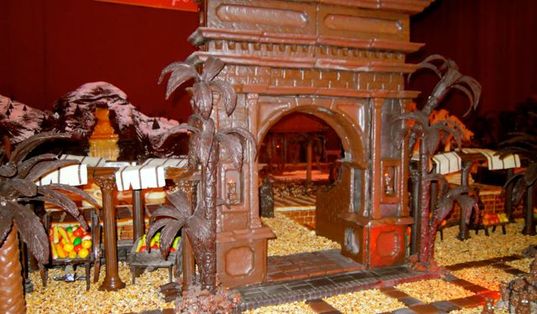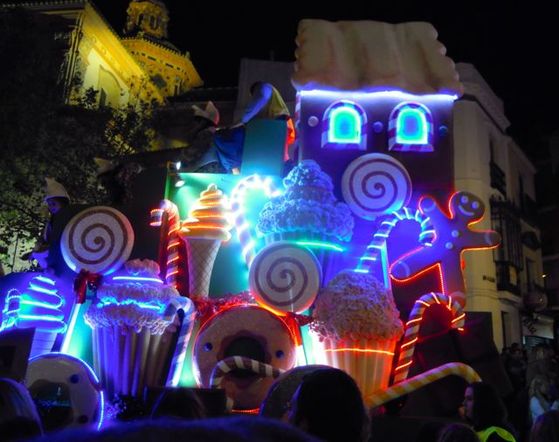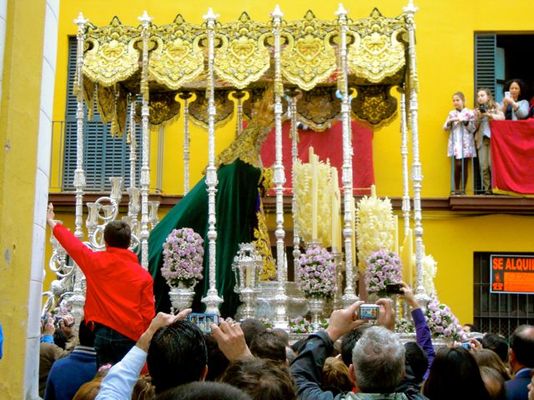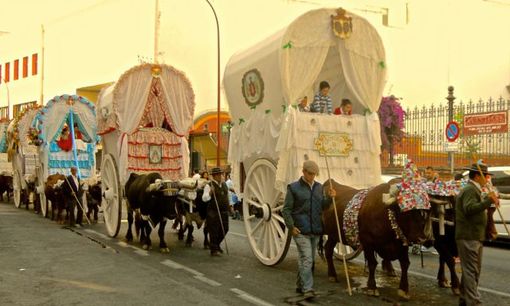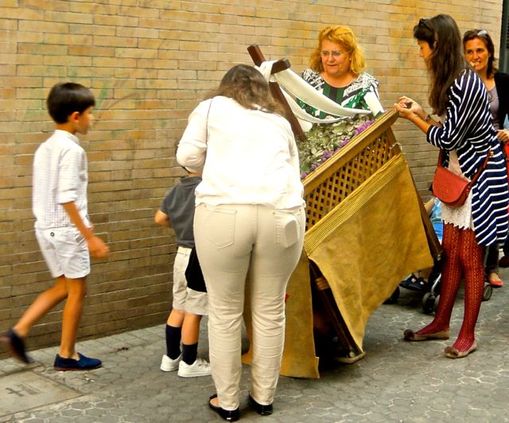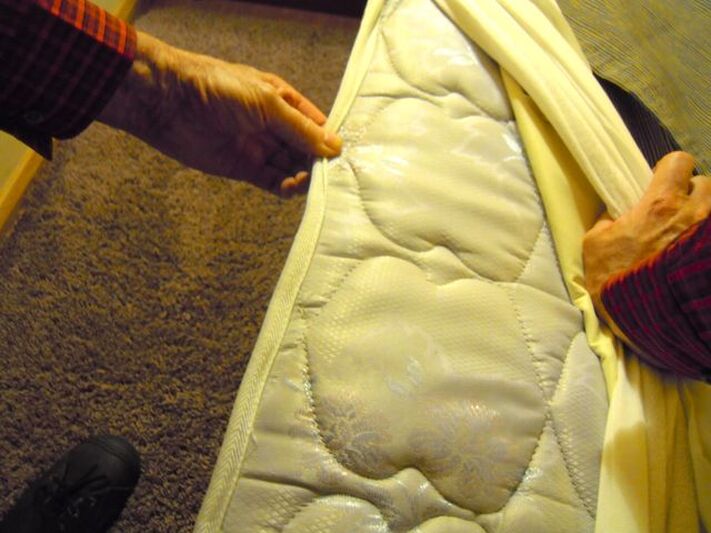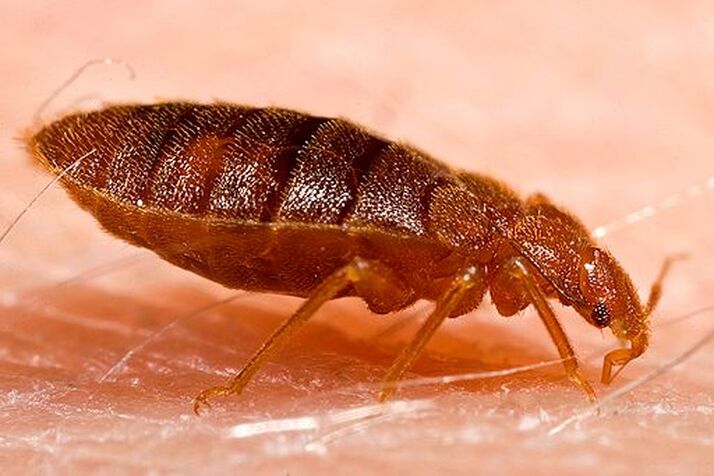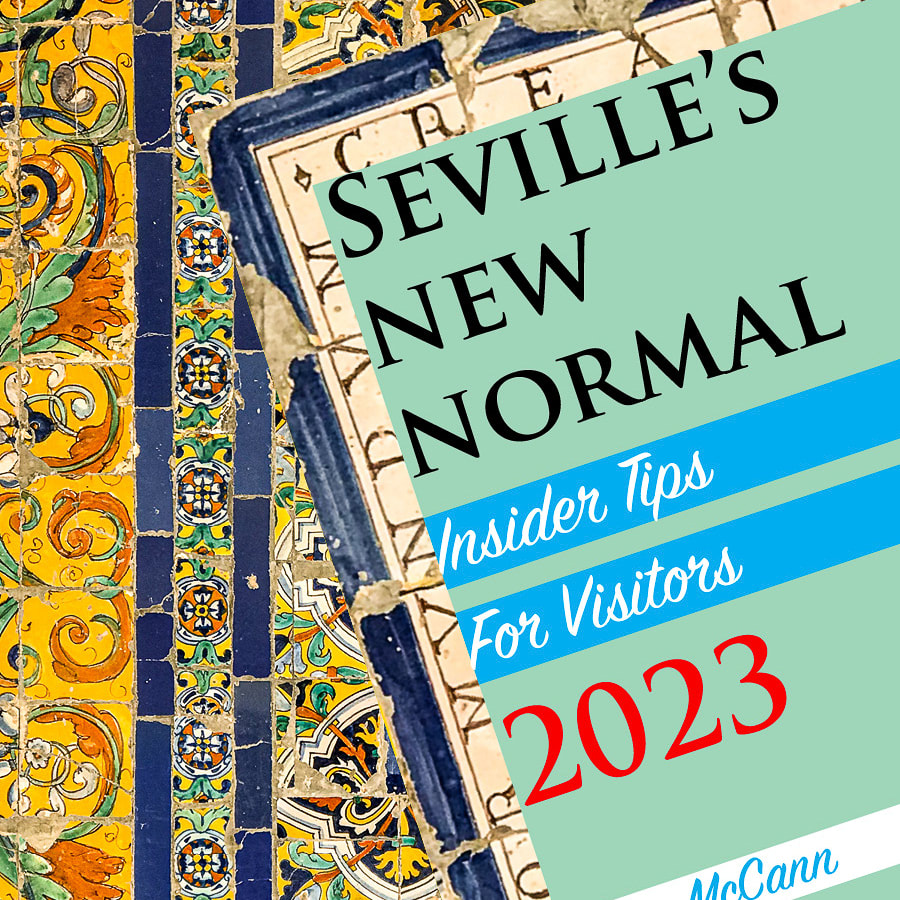|
I love the holidays in Seville, which is good, because here they last from December to early June. The attitude seems to be: Why skimp on the fun? While many of these holidays are based on Catholic religious festivals, their roots are far older, lying deep in way our most ancient ancestors celebrated of the turning of the year and the coming of spring, making their appeal universal. So wherever you live and whatever traditions you honor, there’s no reason you can’t party like the Sevillanos. And the fiestas are just getting started... Christmas, December 24 through January 6 Nothing says “sweet Jesus” quite like an all chocolate Nativity scene with a waterfall and lake of honey and some white chocolate swans. Historically inaccurate? Looking more like Babylon than Bethlehem? Who cares? The Sevillanos love their Nativity scenes. And family gatherings. On December 24 they hold a big family dinner, but this is just the warm-up for the main event on January 6. New Year’s Eve, December 31 Want better luck in 2014? Then underneath your New Year’s Eve party duds, you’d better don red undergarments that you’ve received as a gift; they are sold everywhere in styles that range from nice to very naughty indeed. And at midnight, you’ll swallow one grape at each toll of the bell. This is harder than it sounds; be sure to peel the grapes ahead of time. Los Reyes Magos (the Three Kings), January 5 & 6 In Spain, the Three Kings bring gifts to good boys and girls on January 6th, and on the eve of that happy event, the Cabalgata (Cavalcade) sweeps through Seville, distributing 80,000 kilos (176,000 pounds) of candy from 33 glittering floats. No Cabalgata in your neighborhood? Try throwing candy out the window to your kids and/or friends; they’ll soon get into the spirit of the season! Semana Santa, the week before Easter Every year 55 magnificent processions wind through the city day and night, with statues of a bleeding Jesus and a weeping Mary, and an entourage of nazarenos dressed in robes and conical hats (the ones that inspired the KKK outfits), making it pretty spooky around here, especially at night. For a homemade version of the festival, minus the hoods and the robes, see Cruz de Mayo below. Feria de Abril, two weeks after Semana Santa During this week-long marathon of all-night drinking and dancing, women dress up in eye-popping trajes de flamenca (flamenco outfits), long, skin-tight sheaths that erupt at the knee into cascades of enormous ruffles in vivid colors and patterns, mostly polka dots. No Feria in your town? Wear polka dots and stay up all night dancing and sipping ribujitos (very dry sherry mixed with a soft drink like 7up). Romería del Rocío, held around Pentecost (49 days after Easter) A pilgrimage to honor a sacred effigy of the Virgin in a vast wooded park, this fiesta involves walking or riding in an ox cart for days, wearing a looser style of the traje de flamenca, and partying under the stars late into the night. Don your polka dots, take a long walk in the country, than gather outdoors for cold beer and hot dancing. Cruz de Mayo, May & early June
Now it’s the kids’ turn to stage processions, usually little home-made floats with a wooden cross carried by the neighborhood boys while the girls collect money to pay for the materials. If your kids don’t seem keen to try this, you can always revert to a Romería del Rocío party, which occurs around the same time. With these holidays, Seville marks the entire transition from the shortest, darkest days of winter to the full blossoming of summer, from the dying of the old year to the coming of age of another generation of children. They believe that every day is something to celebrate, and I’m with them all the way on that. Cheers!
8 Comments
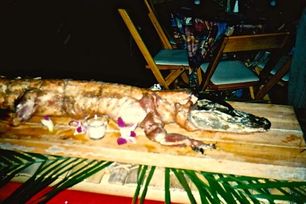 Alligator we served at our 10th anniversary party Alligator we served at our 10th anniversary party “Want to try the fried flies?” asked our Bangkok guide. Who could resist? I popped one in my mouth. For the record, fried flies are salty, oily, crunchy, and much like roasted peanuts – except for the wings. They’re not bad as snacks go. But I don't think you'll find any major fast food franchises asking its customers, "Will you be having flies with that?" I am not a timid eater. Give me a chance to taste exotic foreign fare – snake, pig brains, alligator, bull’s tails, baby eels – and I rarely turn it down. But I finally met my limits last August in a Munich beer hall. I loved Munich’s beer halls and beer gardens. Some could seat thousands of revelers, and even when empty they seemed to ring with drinking songs and roars of bosky laughter. The oldest were built in the 7th century, and a great deal of the city’s history has taken place in them – Mozart writing symphonies, Hitler rising to power, everybody holding his bachelor party. In the Hofbräuhaus, there’s a gutter under the tables, where centuries ago men who were too drunk to stand or didn’t want to face the freezing temperatures in the outdoor privy would simply relieve themselves under the table. Such a practical solution; so hard to see why it died out.  Rich, Mike and Betty in the Augustiner beer garden Rich, Mike and Betty in the Augustiner beer garden Another practical idea: Breakfast in a beer garden. Why wait for happy hour, or even lunch? One Saturday we met our new friend Mike and his mother Betty for a late breakfast under the trees in the enormously popular Augustiner Bräustuben. The centerpiece of the meal was the classic Münchner weisswurst, a white veal sausage, with a side order of pretzels as big as my head. Various beverages appeared in liter-sized steins that – according beer hall custom – had to be lifted one handed. In addition to fruit juices mixed with fizzy soft drinks, we drank weissbier (white beer, known outside of Bavaria as weizenbier, or wheat beer), and russin, a dark wheat beer with a Sprite-like mixer. I turned down offers to try another classic combo, white beer with Coke, because even I have some standards. 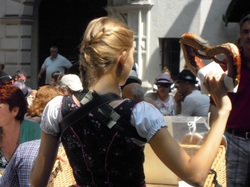 I wasn't kidding about the size of the pretzels. I wasn't kidding about the size of the pretzels. “The food here is very good here,” said Betty. “Yes, it’s delicious,” I said. “No, I mean it’s good for you.” I stared at my portion of weisswurst which (I calculated later) contained 25 grams of fat, 73 grams of cholesterol, and .78 grams of salt. To say nothing of the giant pretzel and liters of beer ... “It’s because we don’t use preservatives,” she added comfortably. In that moment I realized two things. 1) Who was I to judge whether this breakfast was any less healthy than the typical American breakfast of chemicals and white sugar masquerading as a bowl of cereal? And 2) I didn’t have to say “yes” to every opportunity to eat local foods.  Dinner in our Vernoa apartment last August Dinner in our Vernoa apartment last August I wouldn’t have missed my beer garden breakfast for anything; the food, the company, and the cultural experience were delightful. But I was at the beginning of a three-month journey through Central and Eastern Europe, and I was already overwhelmed by the prospect of adapting to a rich, new cuisine every time we stepped off a train. The spirit was willing, but the flesh wasn’t able to keep up with locals who had spent a lifetime tucking into German weisswurst, Czech gulášh or Bulgarian kvarma stew. I began passing up the kielbasa in favor of simple soups and salads, at least much of the time. By showing a bit more common sense at some meals, I felt free to indulge in the local fare at others. When something truly special presented itself, I could say “yes!” or “tak” or “да” with all the enthusiasm I’d shown for the fried flies. Bon appétit! “Ah, civilization,” Rich said as we stumbled into our Romanian hotel just short of midnight. We’d been staying in a rural village that had scarcely changed in 500 years, and it was comforting to be in a modern, well-appointed hotel. A sleepy young woman handed us keys, and when we got to the room, we were so tired, we almost neglected to do a bed-bug check. As you may have heard, the bed bug apocalypse has begun. These hideous parasites have become an unstoppable, worldwide menace since the ban on DDT. A cross between a deadbeat roommate and a vampire, the bed bug lolls around all day in sloth and squalor, burrowing deep into sheets, mattresses, and bed frames. At night it creeps out to feed on human blood, leaving behind red welts like mosquito bites, often in neat rows of three. It can survive 300 days without a meal, but when it does eat, it gorges itself until it swells to alarming proportions. This makes it irresistibly attractive to the nearest male bed bug, which will urgently insist on mating, even if the swollen bug doesn’t happen to be female. We can only imagine the kind of psychological and social problems that causes in the colony. Since Rich and I are not keen to share our bed with a hoard of sex-crazed bloodsuckers, we did a bed-bug check in every one of the 36 places we slept during our three-month train trip through Central and Eastern Europe. On this occasion, in our Romanian hotel, we peeled back the sheets – nothing – and peered into the mattress seams ... wait, what was that? Bed bugs are brown, the length of a grain of rice, and leave behind light brown egg casings. And that’s what we were looking at now: a single brown egg casing. We were out of the room in ten seconds, dragging our bags down to the front desk and demanding another room. The bewildered desk clerk kept saying, “Insects? What...?” Clearly she was unaware that the world is at Defcon Orange in the fight against bed bugs. She accompanied us to another room, watched us tear apart the bed without finding anything, and went away shaking her head. These crazy Americans... A few weeks later in the Bulgarian mountains, we came down to breakfast one morning to discover one of the fellow guests had three red welts in a line on his cheek. “Bed bugs?” I asked, aghast. “I think so,” he said, and was on the next bus out of town – quite possibly to spread his unwanted bedmates to other unsuspecting hosts. The real danger of bed bugs isn’t the bites – which are annoying but generally harmless – it’s having bed bugs hitchhike home with you in your suitcase or computer. Friends who have suffered infestations tell long, grisly tales involving noxious chemicals and sleeping for weeks on plastic-wrapped mattresses to make sure their unwelcome guests were gone – only to discover they weren’t, and the whole process had to start over.  Arriving back in Seville, bed-bug free (we hope) Arriving back in Seville, bed-bug free (we hope) Nowadays, Rich and I perform a vigorous bed-bug check whenever we're away from home. But frankly, that’s about as far as we’re willing to go. One article advised us never to put suitcases on a bed, a carpeted area, or for that matter, on any other part of the floor. That’s fine if you’re in a suite with luggage racks and desks galore, but what were we supposed to do in the bare-bones places we stayed in? Sit up all night holding our suitcases over our heads? We’ve been back in Seville for two months, and so far we haven’t discovered any trace of bed bugs in our luggage, our electronic devices, or around the apartment. Of course, they may just be hiding out, biding their time, hoping to lull us into a false sense of security... I wouldn’t put it past them. 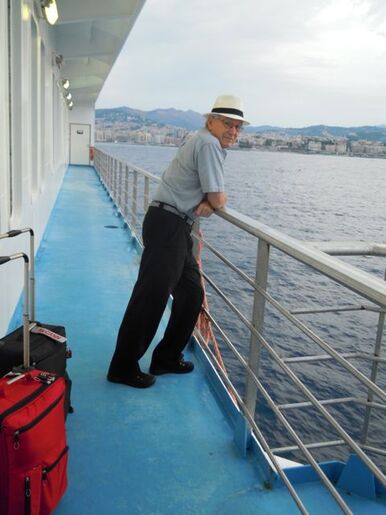 Rich on the ferry arriving in Genoa Rich on the ferry arriving in Genoa “Genoa? Last time I was there, it was full of prostitutes and muggers,” commented a friend upon learning Rich and I were planning to take a ferry there last summer. “Especially down by the docks.” Yikes! Arriving shortly after dawn one August morning, Rich and I felt lucky to get off the ferry and across the wharf with our lives and our wallets. Fifteen minutes later, we were well on our way to being in love with Genoa. Strolling through the nearly deserted streets lined with magnificent old palaces and grand hotels, surrounded by charming if slightly gritty little back streets, we weren’t mugged or propositioned even once. We soon learned that Genoa has been making heroic and successful efforts to reduce the number of nefarious cutthroats per capita on the city streets. Apparently no one has read the memo on this, as visitors continue to stay away in droves, much to the frustration of those in the hospitality industry. They keep pointing out, to anyone who will listen, that city is safe, beautiful, and has all the elements of a major tourist destination – except, of course, actual tourists. Among the things tourists would enjoy (if any of them ever went there) are the treasures acquired during the 500 years that Genoa was a mind-bogglingly wealthy port and financial center. The cathedral alone houses the actual platter on which Salome carried the head of John the Baptist after his decapitation, a splinter of the True Cross, and the Holy Grail. Not everyone is 100% convinced of the authenticity of these sacred objects, especially now that we know the Holy Grail was actually found by Indiana Jones, but nonetheless it’s an impressive collection. And the crown jewel of this treasure trove is the Ark of the Ashes of St. John the Baptist, which is kept in the high altar. As you may recall, John the Baptist is the one who dressed in camel hair, lived on wild locusts and honey, baptized his cousin Jesus in the Jordan River, helped Him launch His ministry, and wound up having his head cut off and served on a platter at the request of Salome. All in all, a pretty colorful life. He’s had a pretty vivid afterlife as well. His bones were buried in Samaria, dug up in 362 and partially burned; some of the remaining bones were carried off to Jerusalem, then Alexandria. His head, after many adventures, is now resting comfortably in the Umayyad Mosque in Damascus; in San Silvestro in Capite in Rome; and in the Residenz Museum in Munich. The Knights Templar also held one at Amiens Cathedral in France for a while, and yet others have been reported in Antioch, Turkey, and in a parish church in Tenterden, Kent.  Salome with the Head of St John the Baptist by Andrea Solario, early 16th century Salome with the Head of St John the Baptist by Andrea Solario, early 16th century In addition to six heads, St. John the Baptist apparently possessed at least three right hands, which are now variously enshrined in the Serbian Orthodox Cetinje Monastery in Montenegro; the Topkapi Palace in Istanbul; and the Romanian Monastery of the Forerunner. Yet more bits of his skeleton have turned up in Calcutta, in Egypt, in Nagorno-Karabakh in the Lesser Caucasus mountains, and as recently as 2010, in a Bulgarian church undergoing renovation. So are the ashes in the Genoa cathedral really those of St. John the Baptist? Does it matter? Every year when they carry the Arc of the Ashes through the streets of the city in a grand procession, the citizens of Genoa know – if only for a moment – what it’s like to be touched by glory. That feeling is real, whether or not the ashes are. Growing up Catholic, I was surrounded by saints and relics and miracles. Since then, I’ve become something of a skeptic, but I’ve always been grateful for my early childhood training in believing impossible things. The world would be a drearier place without it. All the same, if someone offers to sell you a sliver of the True Cross or the actual Holy Grail, I’d demand a lot of authentication. |
This blog is a promotion-free zone.
As my regular readers know, I never get free or discounted goods or services for mentioning anything on this blog (or anywhere else). I only write about things I find interesting and/or useful. I'm an American travel writer living in California and Seville, Spain. I travel the world seeking eccentric people, quirky places, and outrageously delicious food so I can have the fun of writing about them here.
My current project is OUT TO LUNCH IN SAN FRANCISCO. Don't miss out! SIGN UP HERE to be notified when I publish new posts. Planning a trip?
Use the search box below to find out about other places I've written about. Winner of the 2023 Firebird Book Award for Travel
#1 Amazon Bestseller in Tourist Destinations, Travel Tips, Gastronomy Essays, and Senior Travel
BLOG ARCHIVES
July 2024
CATEGORIES
All
|
